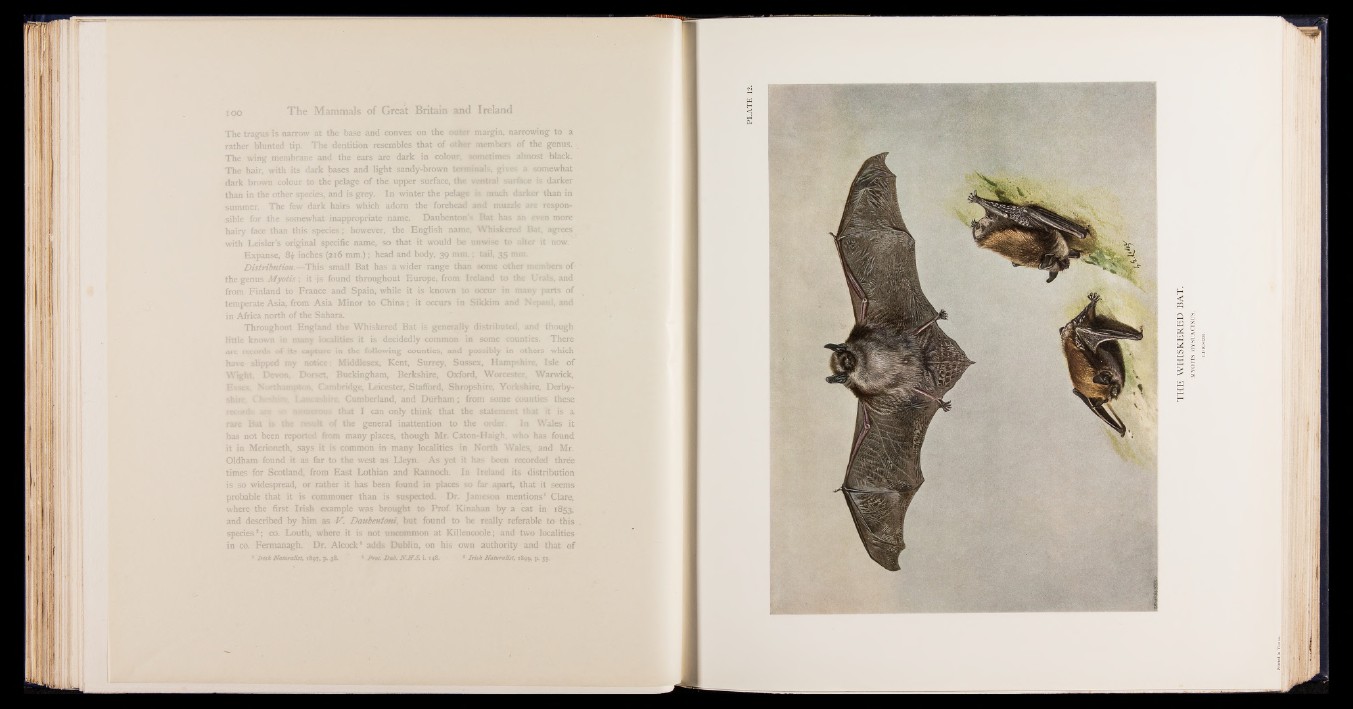
The tragus is narrow at the base and convex on the outer margin, narrowing to a
rather blunted tip. The dentition resembles that of other members of the genus.
The wing membrane and the ears are dark in colour, sometimes almost black.
The hair, with its dark bases and light sandy-brown terminals, gives a somewhat
dark brown colour to the pelage of the- upper surface, the ventral surface is darker
than in the other species, and is grey. In winter the pelage is much darker than in
summer. The few dark hairs which adorn the forehead and muzzle are responsible
for the somewhat inappropriate name. Daubenton’s Bat has an even more
hairy face than this species; however, the English name, Whiskered Bat, agrees
with Leisler’s original specific name, so that it would be unwise to alter it now.
Expanse, 8$ inches (216 mm.); head and body, 39 mm.; tail, 35 mm.
Distribution.— This small Bat has a wider range than some other members of-
the genus M yotis; it is found throughout Europe, from Ireland to the Urals, and
from Finland to France and Spain, while it is known to occur in many parts of
temperate Asia, from Asia Minor to China; it occurs in Sikkim and Nepaul, and
in Africa north of the Sahara.
Throughout England the Whiskered Bat is generally distributed, and though
little known in many localities it is decidedly common in some counties. There
are records of its capture in the following counties, and possibly in others which
have slipped my notice: Middlesex, Kent, Surrey, Sussex, Hampshire, Isle of
Wight, Devon.. Dorset, Buckingham, Berkshire, Oxford, Worcester. Warwick,
Essex, Northampton, Cambridge, Leicester, Stafford, Shropshire, Yorkshire, Derbyshire,
Cheshire, Lancashire, Cumberland, and Durham; from some counties these
*0 nmnerous that I can only think that the statement that it is a
rare Bat is the result of the general inattention to the order. In Wales it
has not been reported from many places, though Mr. Caton-Haigh, who has found
it in Merioneth, says it is common in many localities in North Wales, and Mr.
Oldham found it as far to the west as Lleyn. As yet it has been recorded three
times for Scotland, from East Lothian and Rannoch. In Ireland its distribution
is so widespread, or rather it has been found in places so far apart, that it seems
probable that it is commoner than is suspected. Dr. Jameson mentions1 Clare,
where the first Irish example was brought to Prof. Kinahan by a cat in 1853,
and described by him as V . Daubentoni,, but found to be really referable to this
species*; co. Louth, where it is not uncommon at Killencoole; and two localities
in co. Fermanagh. Dr. Alcock8 adds Dublin, on his own authority and that of
1 Irish Naturalist, 1897, p.38. * JProc. Dub. N .H .S. i. 148. 1 Irish Naturalist, 1899, p. 55.